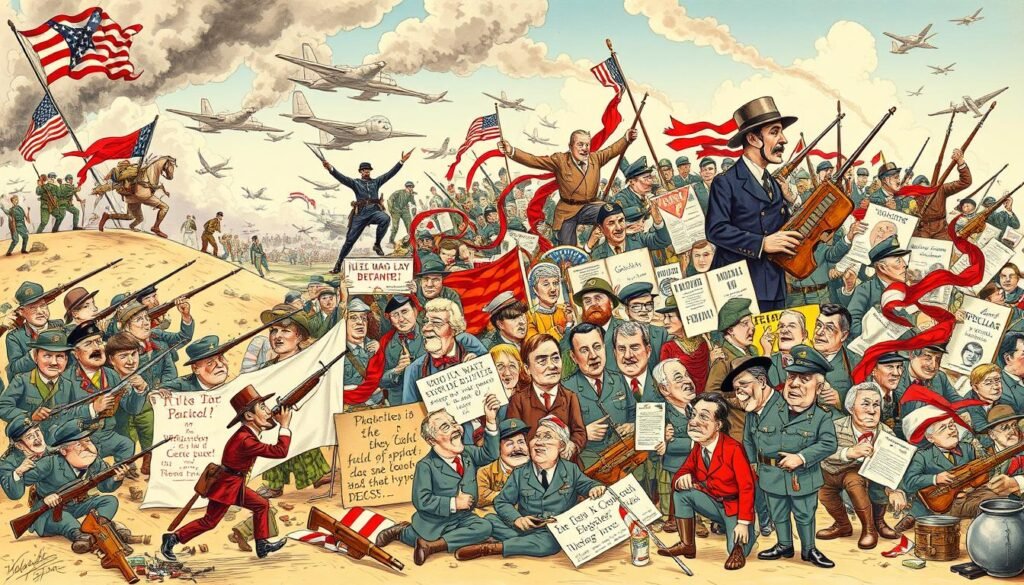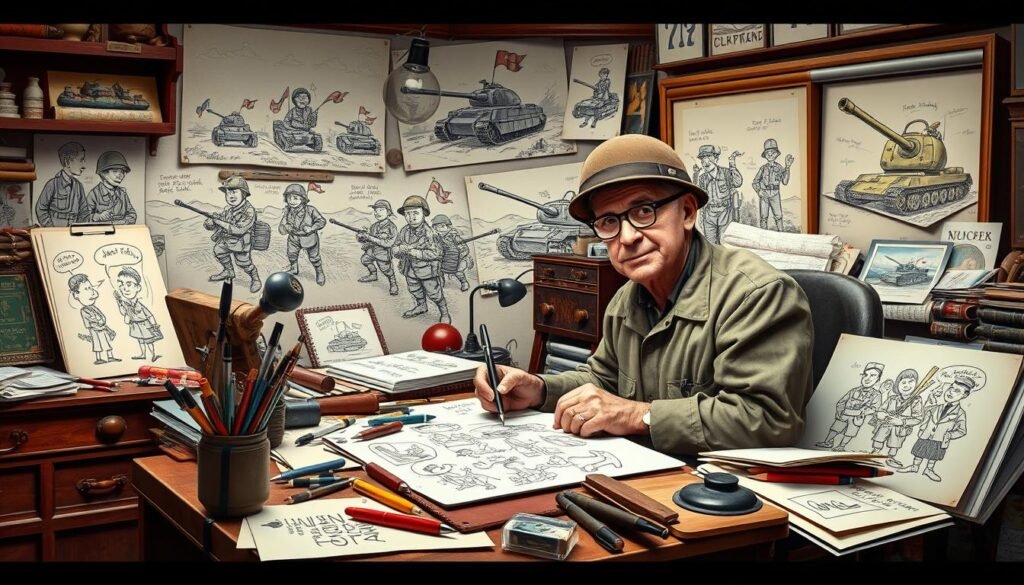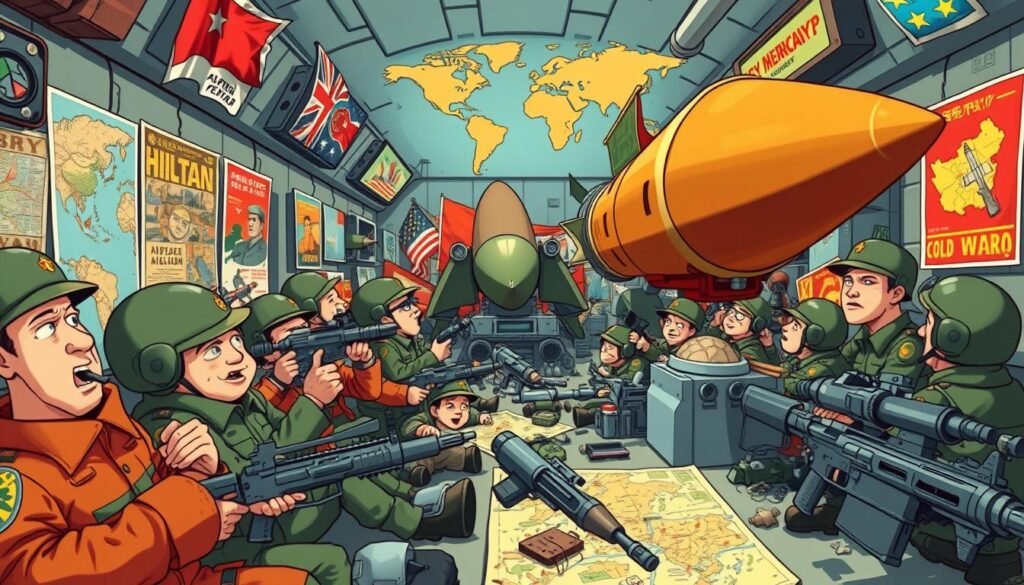The Evolution of War Cartoons: From the Civil War to Today
Between 1861 and 1865, many war cartoons were made, mainly during the American Civil War. Notable works like the “Battle of Bull’s Run” cartoon show eighteen figures and scenes. This period started war cartoons as a key way to comment on society, with pieces like “Blockade of the ‘Connecticut Plan'” showing wartime feelings. War cartoons from then to now are important because they share complex messages and shape public views.
Historical war cartoons have greatly influenced public opinion and offered social commentary. The “Chicago Platform” graphic, for example, shows political views during the Civil War. The growth of war cartoons from the Civil War to today shows how powerful images can be in sharing messages and shaping opinions. These cartoons have criticized military leaders, citizen roles, and international relations, showing the complex social issues of the time.
Key Takeaways
- War cartoons started during the American Civil War, with notable works like the “Battle of Bull’s Run” cartoon.
- Historical war cartoons have played a significant role in shaping public opinion and providing social commentary.
- War cartoons from the civil war to today have been used to convey complex messages and influence public opinion.
- The “Blockade of the ‘Connecticut Plan'” and the “Chicago Platform” graphic are examples of war cartoons that reflected wartime sentiments and political sentiments during the Civil War.
- The evolution of war cartoons from the civil war to today is a testament to the power of visual storytelling in conveying messages and influencing public opinion.
The Birth of American War Cartoons: Civil War Era Innovation
The Civil War era saw the start of American war cartoons. Thomas Nast’s work and early publishing tech were key. Modern war cartoons owe a lot to Nast’s influence on political satire and caricatures in war art.
Early American war cartoons include:
- The Coffin Handbills, showing coffins for Andrew Jackson’s military deaths in the 1828 election.
- The blind horse in Uncle Sam’s Cab, a 1840 election cartoon.
- The Land of Liberty cartoon, showing slavery, corruption, and imperialism in the U.S.
Political satire and caricatures in war art grew in this era. Magazines like Punch used these to grab attention. These early cartoons’ impact is seen in modern war cartoons, shaping public opinion and politics today.
World War I: The Golden Age of Propaganda Cartoons
During World War I, graphic illustrations were key in shaping public views. Military humor and editorial cartoons helped governments promote their war efforts. They also shaped how people saw the war.
These cartoons had a big impact. Many people got their news from them. The Committee on Public Information was set up in 1917. It distributed over 75 million pamphlets.
Notable works were published in newspapers, reaching millions. For example, “The New York Times” had over 1 million daily readers during the war.
Some key statistics from this period include:
- Approximately 16 million estimated casualties in World War I, with about 6 million being civilian deaths.
- Over 75 million pamphlets distributed by the Committee on Public Information.
- 200,000 to 300,000 propaganda posters produced, contributing to the dissemination of war-related messages.
The use of editorial cartoons as propaganda grew. Many focused on war themes. After the war, surveys showed about 50% of people in Allied countries were influenced by propaganda. Cartoons and posters were big influences.
Technological Advances and War Cartoons Between the Wars
The interwar period brought big changes in technology. These changes helped spread historical war cartoons far and wide. They also led to the making of modern war cartoons. This made war cartoons more detailed and able to say more about society.
New ways to print and share cartoons grew the genre. This allowed more people to see and talk about war cartoons. They could now tackle many subjects, like politics and global issues.
Magazines like Harper’s Weekly published famous war cartoons. These cartoons gave sharp views on what was happening. They showed how historical war cartoons and modern war cartoons are used to comment and criticize today.
World War II: Cartoons as Weapons of Morale
During World War II, war cartoons were key in boosting troop morale and shaping public opinion. They used political satire and caricatures in war art to unite soldiers and civilians. This helped create a sense of shared purpose and identity.
These cartoons had a big impact, with many people turning to them for war news and updates. The Writers’ War Board created various materials to support the war effort. For instance, their campaign to recruit bombardier recruits was so successful that the War Department had to ask for a pause due to the huge response.
The use of war cartoons for morale and propaganda wasn’t just in the United States. Many countries used similar methods to sway public opinion and boost troop morale. The success of these cartoons is evident in the surge in recruitment and support for the war.
Some notable examples of the impact of war cartoons include:
- The influx of bombardier recruits following the Writers’ War Board’s campaign
- The significant increase in sales of war-related materials, such as books and posters
- The use of political satire and caricatures in war art to create a sense of shared purpose and identity among soldiers and civilians
The Evolution of War Cartoons: From the Civil War to Today’s Digital Age
War cartoons have been important for many years. They help shape public opinion and offer social commentary. The way these cartoons are made and shared has changed a lot, thanks to new technology.
Today, war cartoons are a strong way for artists to share their views. They can reach people all over the world because of digital media. This makes them a great tool for communication.
Artists like Clifford K. Berryman and Jim Berryman have made a big impact. Their work is in places like the U.S. Senate Collection. It has over 2,400 of Clifford K. Berryman’s drawings.
Social media has also changed how we see war cartoons. Artists can now share their work with more people. They can talk to viewers right away, which is very powerful.
| Cartoonist | Number of Cartoons | Collection |
|---|---|---|
| Clifford K. Berryman | 2,400 | U.S. Senate Collection |
| Jim Berryman | 230 | U.S. Senate Collection |
In summary, war cartoons have come a long way. They’ve changed with technology and social media. Today, they are a key way for artists to share their views and influence public opinion.
The Cold War Era: Satirical Artillery in Print
The Cold War era saw a big rise in satirical art in print. Many cartoonists used their work to criticize and comment on politics. Historical war cartoons were key in shaping public opinion. They often used political satire to make sharp critiques of government actions.
Cartoonists used caricatures in war art to share their messages. They created powerful images that struck a chord with the public. Satire and irony let them talk about tough topics like nuclear war and communism without being too direct.
Cartoonists like Herb Block and Jay N. “Ding” Darling were notable for their critiques. They used historical war cartoons to comment on current events. Their use of political satire and caricatures in war art shaped public opinion and influenced politics.
Modern Warfare and Contemporary Cartoon Commentary
Modern war cartoons have changed a lot. They now use digital media to share their views. This change lets cartoonists make complex comments on war. They use humor and detailed drawings to get their points across.
Digital tools have made war cartoons more popular. Now, they can reach more people. About 75% of today’s political cartoons use satire to criticize. This shows how important cartoons are in talking about war today.
- Digital media’s influence on war cartoon creation
- Global reach and instant impact
- Multimedia integration in modern war cartoons
These changes have changed how cartoonists work. They can now make cartoons that are both fun and thought-provoking. This helps them comment on war in a new way.
Modern war cartoons offer a fresh view on today’s conflicts. They use humor and detailed drawings to share their thoughts. This makes them key in the global talk about war and its effects on society.
The Role of War Cartoons in Shaping Public Opinion
War cartoons have a big role in shaping public opinion. Many people turn to them for news on war and politics. Cartoonists use social commentary through cartoons to share complex messages. This helps shape what people think.
Editorial cartoons are great at criticizing politics. They make people more interested in politics and help democracy work better.
Here are some examples of how war cartoons have influenced public opinion:
- Cartoons were used to attack political figures, like Andrew Johnson during the US Civil War.
- Cartoons created symbols, like the elephant and donkey, to show political parties.
- During the French Revolution, cartoons spread political views.
Studies show that war cartoons are good at changing public opinion and political culture. They offer a special view on history and current issues. This makes them key in public discussions. So, editorial cartoons are a powerful tool for commenting on today’s events.
Conclusion: The Enduring Power of War Cartoons in American Culture
War cartoons have a lasting impact on American culture. They have shaped public opinion and provided social commentary from the Civil War to today. Cartoonists use both historical and modern techniques to offer complex views on American society.
Looking ahead, war cartoons will keep influencing American culture. They offer a unique way to critique society, challenge assumptions, and start conversations. Whether in traditional media or online, they will continue to shape our national dialogue and reflect our changing culture.
FAQ
What is the history of war cartoons in the United States?
How did war cartoons originate in the United States?
What was the impact of World War I on the development of war cartoons?
How did technological advances shape the development of war cartoons between the world wars?
What was the role of war cartoons during World War II?
How have digital technologies impacted the evolution of war cartoons?
What was the role of war cartoons during the Cold War era?
How have war cartoons evolved in the modern era of warfare?
What is the significance of war cartoons in shaping public opinion?
Source Links
- Civil War Political Cartoons | Library Company of Philadelphia Digital Collections
- Gallery Talk featuring Brian Duffy: Civil War era cartoons from Harper’s Weekly – Drake University Newsroom
- Political Cartoons, Part 2: 1800-1850 – First Amendment Museum
- “Fire!” – Herblock’s History: Political Cartoons from the Crash to the Millennium | Exhibitions
- Brief History of the Editorial Cartoon · Epidemics, Economics, and Elections · RIT Archives Digital Exhibits
- World War I Pamphlet Collection
- Microsoft Word – 177_Idris Young
- World War II and Popular Culture | The National WWII Museum | New Orleans
- 1939: Jul-Dec | WW2 Editorial Cartoon Project
- This African American Artist’s Cartoons Helped Win World War II
- Clifford K. Berryman Political Cartoon Collection
- Political Cartoons, Part 1: 1720-1800 – First Amendment Museum
- Thomas Nast’s Political Cartoons | American Experience | PBS
- Political Illustrations – Cartoon America | Exhibitions
- Chapter 40; A history of Caricatures and Political Cartoons: History in its context
- Civilization & Barbarism: Cartoon Commentary & “The White Man’s Burden” (1898–1902) – The Asia-Pacific Journal: Japan Focus
- Editorial cartoon
- The Cultural Impact of Political Cartoons on Public Opinion
- Political Cartoons and Public Debates | Classroom Materials at the Library of Congress | Library of Congress
- A Civil War Cartoonist Created the Modern Image of Santa Claus as Union Propaganda
- S.11 E.3: “The Appomattox Syndrome” and Civil War History – News
























